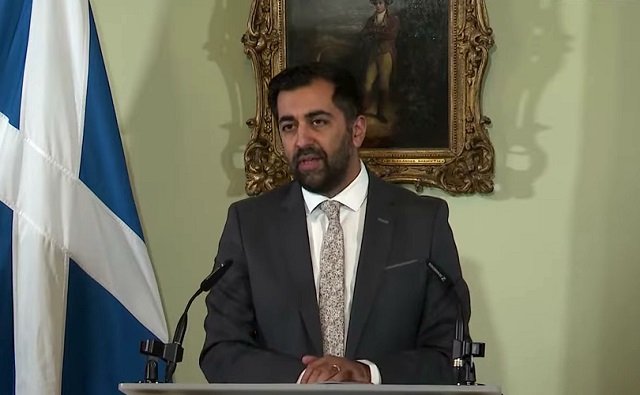Opinion
Does Scottish gov’t turmoil signal the end of the ‘green’ agenda’s stranglehold on Europe?

Former Scottish First Minister Humza Yousaf
From LifeSiteNews
By Frank Wright
‘Green’ politics is now understood as a campaign for electoral and national suicide. With the coming European elections the writing is on the wall for globalist ‘progressives’ across the continent.
The First Minister of Scotland, Humza Yousaf, quit on live television on April 29, following the collapse of his left/Green Party coalition government. A power sharing agreement between his bizarrely named Scottish National Party (SNP) and the Greens was broken over the SNP’s retreat on Net Zero commitments.
Despite his camera savvy assertions, Yousaf’s departure has nothing to do with either duty or principle, which he stressed in the speech announcing his resignation. It is the result of a feared public backlash against higher taxes, over-regulation, and the madness of progressive “green” policies which prefigures a European political realignment.
READ: Net Zero’s days are numbered? Why Europeans are souring on the climate agenda
Yousaf’s coalition with the Greens fell apart because his SNP had recognized that the extreme Net Zero agenda was unrealistic, and could deliver only electoral suicide. The SNP under Yousaf had abandoned its “decarbonization targets” in early April, with Green co-leaders Lorna Slater and Patrick Harvie describing Yousaf’s attempts to ditch extremely unpopular policies as “an act of political cowardice” and a “betrayal.”
As a result, the Greens withdrew support from the SNP, which fell one seat short of a majority in 2021. A new deal with a new leader is unlikely, and the chaos spells doom for the SNP with an election coming this year. The SNP remains in power – for the time being – albeit in a minority government.
Wider lessons for globalist ‘greens’
The lesson from Scotland is that the liberal parties of Europe face electoral meltdown. A recent report from the European Council on Foreign Relations (ECFR) warned of a “sharp right turn” following EU elections in June:
Inside the European Parliament, a populist right coalition of Christian democrats, conservatives, and radical right MEPs could emerge with a majority for the first time.
The future spells doom for the doomsayers, it seems, with the globalist agenda under severe threat. The existence of the globalist EU itself may be threatened, with Unherd saying in December that this decade may be the EU’s last.
The ECFR report continued:
This ‘sharp right turn’ is likely to have significant consequences for European-level policies, which will affect the foreign policy choices that the EU can make, particularly on environmental issues, where the new majority is likely to oppose ambitious EU action to tackle climate change.
The attempt of the SNP to avoid electoral oblivion has only made it fall faster. It is an example which will be nervously observed from the once-dominant power in Europe.
Germany next?
The SNP’s partnership in power with the “green” zealots mirrors that of the government of Europe’s former economic and industrial powerhouse, Germany.
The crisis-hit Scholz administration relies on the support of a Green party whose policies have not only devastated the economy with deindustrialization, lockdown debt, and soaring energy prices, but have also, as in Scotland, advanced a raft of extremist “progressive” issues, such as the promotion of the “trans” movement, opposition to border and immigration control, with both Green parties pursuing policies strongly resented by the public.
Scotland’s Greens sought to ban wood-burning stoves, and Germany’s Greens were met with similar outrage with their decision to ban gas-fired central heating, and mandate the use of heat pumps. Yet the money for the subsidies required has run out – as “green” policies have helped to destroy the economy.
The Greens succeeded in closing the last of Germany’s nuclear power stations in August 2023, but the policy of replacing home heating which works with an expensive alternative that does not, was met with widespread opposition.
As a result, it is not just heat pump sales that have plummeted in Germany, but the sales pitch of the international “green” lobby.
Faced with defeat in the European elections, which the ECFR blames on “national parties start[ing] to respond to the changing opinions of their voters,” many parties of the liberal establishment are rowing back on Net Zero commitments – as well as on other issues beloved of the shock-haired shock troops of “progress.”
The face of globalist progressives
The co-leader of the Scottish Greens is Patrick Harvie, whose social media accounts notify readers that his pronouns are he/him.

The causes he supports are an object lesson in how Net Zero is not the only crazy agenda aggressively pushed by the Greens, whose policy platform is increasingly seen as electorally toxic. He is a self-described member of the so-called “LGBTQ+ community,” identifying as “bisexual.”
Like many progressive fanatics, he strongly supports the futile and avoidable destruction of the population and nation of Ukraine.
Here he is in 2020, championing the prescription of hormones and surgery to sexualized children as “trans healthcare.”
I wish I could say it was shocking that an MSP today called on the First Minister to instruct the NHS to withdraw trans healthcare from young people.
Trans healthcare already suffers from unacceptably long waits, even for referral. Greens will continue to push for improvement. https://t.co/9iXwQ8zmUz
— Patrick Harvie 🇪🇺🌈 (@patrickharvie) December 10, 2020
Naturally, he repeatedly describes Christians with disdain, labelling the Christian Institute as a “hate group.” The institute “campaigns for “the furtherance and promotion of the Christian religion in the United Kingdom and elsewhere.”
The NSS recently agreed that after his latest outburst the racist historian David Starkey had to be removed as an Honorary Associate. They accepted that his racism was a red line. Why should homophobia, transphobia and misogyny be treated any differently?
— Patrick Harvie 🇪🇺🌈 (@patrickharvie) July 31, 2020
As Britain’s Telegraph reported, explaining the background to the collapse of Yousaf’s SNP-Green coalition:
Harvie’s determination to indulge his permanently-angry purple-haired activists even at the expense of the Scottish Government’s credibility was probably the last straw for many senior SNP ministers, if not for Yousaf himself.
Harvie is a strong advocate of abortion. He and his party describe the reminder that the lives of unborn children have value as “misinformation and intimidation,” as they seek to afford “dignity and privacy” to women killing their children, “as they are at every other medical procedure.”
SPUC, the Society for the Protection of Unborn Children, pointed out that the measure to legally enforce “buffer zones” around abortion facilities was “opposed by 70 percent” of the Scottish public.
The Greens in Scotland, as in Germany, vehemently oppose any attempt to control mass migration – however weak and belated.
The Greens have also refused to alter their stance on the now discredited notion of “gender affirming care” for children.
Against scientific advice, the Greens prefer to support the views of the “trans community,” saying “lived experience” is a better guide to reality than the clinical evidence that prescribing hormones and surgery to confused children is wrong, and causes irreversible harm.
The U.K.’s Cass Review, published in mid-April, cited a lack of “evidence based guidelines,” noting that pro-transgender organizations such as WPATH had exerted considerable influence in the adoption of the Dutch Pathway – a template which resulted in rapid access to hormones and surgery including for children.
Cass said in her introduction, “Although some think the clinical approach should be based on a social justice model, the NHS works in an evidence-based way.”
The rejection of the fast track to “puberty blockers” mirrors a similar preference for evidence-based decisions in Western electorates.
The Godless, nation-wrecking policies of national suicide have produced enough evidence of the motives, methods, and monumental disaster of the globalist Green agenda. It is anti-natalist, pro-open borders, anti-family, and seeks to promote the sexual distortion of the lives of what few children we still have. In a final irony, is also destroying the economic prosperity on whose subsidies it relies for its own survival.
Happily, “green” politics is now understood as a campaign for electoral as well as national suicide. This realization has spelled the end of the appalling Scottish coalition government, and with the coming European elections the writing is on the wall for globalist “progressives” across the continent.
Humza Yousaf’s left/Green government was just the first Green-backed coalition which has ended in disaster. It will not be the last. For the reality based community, the best news is yet to come.
Business
Large-scale energy investments remain a pipe dream

I view the recent announcements by the Government of Canada as window dressing, and not addressing the fundamental issue which is that projects are drowning in bureaucratic red tape and regulatory overburden. We don’t need them picking winners and losers, a fool’s errand in my opinion, but rather make it easier to do business within Canada and stop the hemorrhaging of Foreign Direct Investment from this country.
Thanks for reading William’s Substack!
Subscribe for free to receive new posts and support my work.
Changes are afoot—reportedly, carve-outs and tweaks to federal regulations that would help attract investment in a new oil pipeline from Alberta. But any private proponent to come out of this deal will presumably be handpicked to advance through the narrow Bill C-5 window, aided by one-off fixes and exemptions.
That approach can only move us so far. It doesn’t address the underlying problem.
Anyone in the investment world will tell you a patchwork of adjustments is nowhere near enough to unlock the large-scale energy investment this country needs. And from that investor’s perspective, the horizon stretches far beyond a single political cycle. Even if this government promises clarity today in the much-anticipated memorandum of understanding (MOU), who knows whether it will be around by the time any major proposal actually moves forward.
With all of the talk of “nation-building” projects, I have often been asked what my thoughts are about what we must see from the federal government.
The energy sector is the file the feds have to get right. It is by far the largest component of Canadian exports, with oil accounting for $147 billion in 2024 (20 percent of all exports), and energy as a whole accounting for $227 billion of exports (30 percent of all exports).
Furthermore, we are home to some of the largest resource reserves in the world, including oil (third-largest in proven reserves) and natural gas (ninth-largest). Canada needs to wholeheartedly embrace that. Natural resource exceptionalism is exactly what Canada is, and we should be proud of it.
One of the most important factors that drives investment is commodity prices. But that is set by market forces.
Beyond that, I have always said that the two most important things one considers before looking at a project are the rule of law and regulatory certainty.
The Liberal government has been obtuse when it comes to whether it will continue the West Coast tanker ban (Bill C-48) or lift it to make way for a pipeline. But nobody will propose a pipeline without the regulatory and legal certainty that they will not be seriously hindered should they propose to build one.
Meanwhile, the proposed emissions cap is something that sets an incredibly negative tone, a sentiment that is the most influential factor in ensuring funds flow. Finally, the Impact Assessment Act, often referred to as the “no more pipelines bill” (Bill C-69), has started to blur the lines between provincial and federal authority.
All three are supposedly on the table for tweaks or carve-outs. But that may not be enough.
It is interesting that Norway—a country that built its wealth on oil and natural gas—has adopted the mantra that as long as oil is a part of the global economy, it will be the last producer standing. It does so while marrying conventional energy with lower-carbon standards. We should be more like Norway.
Rather than constantly speaking down to the sector, the Canadian government should embrace the wealth that this represents and adopt a similar narrative.
The sector isn’t looking for handouts. Rather, it is looking for certainty, and a government proud of the work that they do and is willing to say so to Canada and the rest of the world. Foreign direct investment outflows have been a huge issue for Canada, and one of the bigger drags on our economy.
Almost all of the major project announcements Prime Minister Mark Carney has made to date have been about existing projects, often decades in the making, which are not really “additive” to the economy and are reflective of the regulatory overburden that industry faces en masse.
I have always said governments are about setting the rules of the game, while it is up to businesses to decide whether they wish to participate or to pick up the ball and look elsewhere.
Capital is mobile and will pursue the best risk-adjusted returns it can find. But the flow of capital from our country proves that Canada is viewed as just too risky for investors.
The government’s job is not to try to pick winners and losers. History has shown that governments are horrible at that. Rather, it should create a risk-appropriate environment with stable and capital-attractive rules in place, and then get out of the way and see where the chips fall.
Link to The Hub article: Large-scale energy investments remain a pipe dream
Formerly the head of institutional equity research at FirstEnergy Capital Corp and ATB Capital Markets. I have been involved in the energy sector in either the sell side or corporately for over 25 years
Thanks for reading William’s Substack!
Subscribe for free to receive new posts and support my work.
Business
I Was Hired To Root Out Bias At NIH. The Nation’s Health Research Agency Is Still Sick


From the Daily Caller News Foundation
By Joe Duarte
Federal agencies like the National Institutes of Health (NIH) continue to fund invalid, ideologically driven “scientific” research that subsidizes leftist activists and harms conservatives and the American people at large. There’s currently no plan to stop.
Conversely, NIH does not fund obvious research topics that would help the American people, because of institutional leftist bias.
While serving as a senior advisor at NIH, I discovered many active grants like these:
“Examining Anti-Racist Healing in Nature to Protect Telomeres of Transitional Age BIPOC for Health Equity” — Take minority teens to parks in a bid to reduce telomere erosion (the shortening of repetitive DNA sequences as we age). $3.8 million in five years and no results published – not surprising, given their absurd premise.
“Ecological Momentary Assessment of Racial/Ethnic Microaggressions and Cannabis Use among Black Adults” – This rests on an invalid leftist ideological concept – “microaggressions.” An example of a “microaggression” is a white person denying he’s racist. They can’t be validly measured since they’re simply defined into existence by Orwellian leftist ideology, with no attempt to discover the alleged aggressor’s motives.
“Influence of Social Media, Social Networks, and Misinformation on Vaccine Acceptance Among Black and Latinx Individuals” — from an activist who said the phrase “The coronavirus is genetically engineered” was “misinformation” and also conducted a bizarre, partisan study based entirely on a Trump tweet about recovering from COVID.
I will be leaving the great Walter Reed Medical Center today at 6:30 P.M. Feeling really good! Don’t be afraid of Covid. Don’t let it dominate your life. We have developed, under the Trump Administration, some really great drugs & knowledge. I feel better than I did 20 years ago!
— Donald J. Trump (@realDonaldTrump) October 5, 2020
The study claimed that people saw COVID as less “serious” after the tweet. I apologize for the flashback to when Democrats demanded everyone feel the exact level of COVID panic and anti-optimism they felt (and share their false beliefs on the efficacy of school closures, masks, and vaccines ). NIH funded this study and gave him another $651,586 in July for his new “misinformation” study, including $200,000 from the Office of the Director.
I’m a social psychologist who has focused on the harms of ideological bias in academic research. Our sensemaking institutions have been gashed by a cult political ideology that treats its conjectures and abstractions as descriptively true, without argument or even explanation, and enforces conformity with inhumane psychologizing and ostracism. This ideology – which dominates academia and NIH – poses an unprecedented threat to our connection to reality, and thus to science, by vaporizing the distinction between descriptive reality and ideological tenets.
In March, I emailed Jay Bhattacharya, Director of NIH, and pitched him on how I could build an objective framework to eliminate ideological bias in NIH-funded research.
Jay seemed to agree with my analysis. We spoke on the phone, and I started in May as a senior advisor to Jay in the Office of the Director (NIH-OD).
I never heard from Jay again beyond a couple of cursory replies.
For four months, I read tons of grants, passed a lengthy federal background check, started to build the pieces, and contacted Jay about once a week with questions, follow-up, and example grants. Dead air – he was ghosting me.
Jay also bizarrely deleted the last two months’ worth of my messages to him but kept the older ones. I’d sent him a two-page framework summary, asked if I should keep working on it, and also asked if I’d done something wrong, given his persistent lack of response. No response.
In September, the contractors working at NIH-OD, me included, were laid off. No explanation was given.
I have no idea what happened here. It’s been the strangest and most unprofessional experience of my career.
The result is that NIH is still funding ideological, scientifically invalid research and will continue to ignore major topics because of leftist bias. We have a precious opportunity for lasting reform, and that opportunity will be lost without a systematic approach to eliminating ideology in science.
What’s happened so far is that DOGE cut some grants earlier this year, after a search for DEI terms. It was a good first step but caught some false positives and missed most of the ideological research, including many grants premised on “microaggressions,” “systemic racism,” “intersectionality,” and other proprietary, question-begging leftist terms. Leftist academics are already adapting by changing their terminology – this meme is popular on Bluesky:
DOGE didn’t have the right search terms, and a systematic, objective anti-bias framework is necessary to do the job. It’s also more legally resilient and persuasive to reachable insiders — there’s no way to reform a huge bureaucracy without getting buy-in from some insiders (yes, you also have to fire some people). This mission requires empowered people at every funding agency who are thoroughly familiar with leftist ideology, can cleanly define “ideology,” and build robust frameworks to remove it from scientific research.
My framework identifies four areas of bias so far:
- Ideological research
- Rigged research
- Ideological denial of science / suppression of data
- Missing research – research that would happen if not for leftist bias
The missing research at NIH likely hurts the most — e.g. American men commit suicide at unusually high rates, especially white and American Indian men, yet NIH funds no research on this. But they do fund “Hypertension Self-management in Refugees Living in San Diego.”
Similarly, NIH is AWOL on the health benefits of religious observance and prayer, a promising area of research that Muslim countries are taking the lead on. These two gaping holes suggest that NIH is indifferent to the American people and even culturally and ideologically hostile them.
Joe Duarte grew up in small copper-mining towns in Southern Arizona, earned his PhD in social psychology, and focuses on political bias in media and academic research. You can find his work here, find him on X here, and contact him at gravity at protonmail.com.
-

 Energy1 day ago
Energy1 day agoExpanding Canadian energy production could help lower global emissions
-

 Business1 day ago
Business1 day agoWill the Port of Churchill ever cease to be a dream?
-

 Great Reset2 days ago
Great Reset2 days agoEXCLUSIVE: The Nova Scotia RCMP Veterans’ Association IS TARGETING VETERANS with Euthanasia
-

 Daily Caller2 days ago
Daily Caller2 days agoSpreading Sedition? Media Defends Democrats Calling On Soldiers And Officers To Defy Chain Of Command
-

 COVID-1919 hours ago
COVID-1919 hours agoFreedom Convoy protestor Evan Blackman convicted at retrial even after original trial judge deemed him a “peacemaker”
-

 Health2 days ago
Health2 days agoDisabled Canadians petition Parliament to reverse MAiD for non-terminal conditions
-

 Business1 day ago
Business1 day agoThe numbers Canada uses to set policy don’t add up
-

 Business1 day ago
Business1 day agoNew airline compensation rules could threaten regional travel and push up ticket prices






